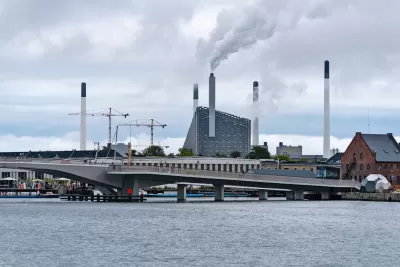Bettina Kamuk, global market director for Ramboll, explains how a Copenhagen waste-to-energy facility meets air quality and emissions standards while providing low-carbon energy and recreational activity to the surrounding community.

With China no longer accepting imports of post-consumer recyclables from the United States, California’s waste facilities are struggling to manage the sudden increase in volume and demand on its waste disposal facilities. Waste-to-energy conversion plants—a staple of European circular economic models to address waste management and reach decarbonization goals— face, despite success in Europe, significant public relations and political challenges in U.S. cities.
To better understand the latest innovative science behind waste-fired power plants globally, TPR recently toured Amager Bakke, a waste-to-energy plant (and, yes, ski slope attraction) in Copenhagen, Denmark; and, spoke with Bettina Kamuk, Global Market Director for Ramboll, who explained how the Copenhagen facility meets air quality and emissions standards while providing low-carbon energy and recreational activity to its surrounding community.
"The Amager Bakke waste-to-energy (WtE) facility, which we engineered and designed, supplies one-third of all heat to Copenhagen, and is part of Denmark’s 2010 national strategy to reduce all dependency on fossil fuels by 2030. The Amager Bakke WtE facility is owned and operated by Amager Resource Centre (ARC), a five city consortia, to supply low-carbon electricity to 550,000 people and district heating to 140,000 households.
This plant replaced a 45-year-old facility. ARC’s objectives were to replace the aging lines of this facility, produce a lower emission, more efficient plant that would have a higher recovery of materials like metals, and be a beacon for the city, open to the public. Everyone knows that we are building a ski slope on the roof and that this facility is in the center of the city. We don’t hide what we’re doing. We show what we’re doing with our waste."
Read the full interview on The Planning Report.
FULL STORY: Denmark's Amager Bakke Waste-to-Energy Plant: a Global Model of Sustainable Design & Efficiency

Planetizen Federal Action Tracker
A weekly monitor of how Trump’s orders and actions are impacting planners and planning in America.

San Francisco's School District Spent $105M To Build Affordable Housing for Teachers — And That's Just the Beginning
SFUSD joins a growing list of school districts using their land holdings to address housing affordability challenges faced by their own employees.

Vehicle-related Deaths Drop 29% in Richmond, VA
The seventh year of the city's Vision Zero strategy also cut the number of people killed in alcohol-related crashes by half.

The EV “Charging Divide” Plaguing Rural America
With “the deck stacked” against rural areas, will the great electric American road trip ever be a reality?

Judge Halts Brooklyn Bike Lane Removal
Lawyers must prove the city was not acting “arbitrarily, capriciously, and illegally” in ordering the hasty removal.

Engineers Gave America's Roads an Almost Failing Grade — Why Aren't We Fixing Them?
With over a trillion dollars spent on roads that are still falling apart, advocates propose a new “fix it first” framework.
Urban Design for Planners 1: Software Tools
This six-course series explores essential urban design concepts using open source software and equips planners with the tools they need to participate fully in the urban design process.
Planning for Universal Design
Learn the tools for implementing Universal Design in planning regulations.
Borough of Carlisle
Smith Gee Studio
City of Camden Redevelopment Agency
City of Astoria
Transportation Research & Education Center (TREC) at Portland State University
City of Camden Redevelopment Agency
Municipality of Princeton (NJ)


























